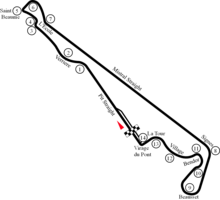
The 1974 Argentine Grand Prix was a Formula One motor race held in Buenos Aires on 13 January 1974. It was race 1 of 15 in both the 1974 World Championship of Drivers and the 1974 International Cup for Formula One Manufacturers. The 53-lap race was won by McLaren driver Denny Hulme after he started from tenth position. Niki Lauda finished second for the Ferrari team and his teammate Clay Regazzoni came in third.

The 1974 South African Grand Prix was a Formula One motor race held at Kyalami on 30 March 1974. It was race 3 of 15 in both the 1974 World Championship of Drivers and the 1974 International Cup for Formula One Manufacturers. This was Carlos Reutemann's first win, the first for an Argentinian driver since Juan Manuel Fangio won the 1957 German Grand Prix, and Brabham's first since the 1970 South African Grand Prix.

The 1974 Belgian Grand Prix was a Formula One motor race held at Nivelles on 12 May 1974. It was race 5 of 15 in both the 1974 World Championship of Drivers and the 1974 International Cup for Formula One Manufacturers. The 85-lap race was won by Brazilian driver Emerson Fittipaldi, driving a McLaren-Ford, with Austrian Niki Lauda a close second in a Ferrari and South African Jody Scheckter third in a Tyrrell-Ford. This race also marked the debut of Tom Pryce, making his first start for the newly formed Token team.

The 1974 French Grand Prix was a Formula One motor race held at Dijon-Prenois near Dijon, France on 7 July 1974. It was race 9 of 15 in both the 1974 World Championship of Drivers and the 1974 International Cup for Formula One Manufacturers.

The 1975 Argentine Grand Prix was a Formula One motor race held at Buenos Aires on 12 January 1975. It was race 1 of 14 in both the 1975 World Championship of Drivers and the 1975 International Cup for Formula One Manufacturers. It was the twelfth Argentine Grand Prix and only the second to be held on the lengthened six kilometre version of the race track that runs out towards Curvon Salotto around the lake which lies to the north-east of the circuit.

The 1975 Spanish Grand Prix was a Formula One motor race held at Montjuïc circuit on 27 April 1975. It was race 4 of 14 in both the 1975 World Championship of Drivers and the 1975 International Cup for Formula One Manufacturers. It is a landmark, controversial, and tragic race weekend. Lella Lombardi became the first and, as of 2024, only woman to score points in the World Championship. Lombardi scored 0.5 points as this was the first time a race was stopped before 60% completion leading to the awarding of half the points that would be awarded for a completed race. During the race four spectators were hit by the Hill GH1 of Rolf Stommelen, after he crashed and landed in a spectator area, causing their deaths. The race was also future world champion Alan Jones' first Grand Prix start.

The 1975 Monaco Grand Prix was a Formula One motor race held in Monaco on 11 May 1975. It was race 5 of 14 in both the 1975 World Championship of Drivers and the 1975 International Cup for Formula One Manufacturers. It was the 33rd Monaco Grand Prix since the race was first held in 1929. It was held over 75 of the scheduled 78 laps of the three kilometre street circuit, for a race distance of 245 kilometres.

The 1975 Belgian Grand Prix was a Formula One motor race held at Zolder on 25 May 1975. It was race 6 of 14 in both the 1975 World Championship of Drivers and the 1975 International Cup for Formula One Manufacturers. It was the 33rd Belgian Grand Prix and the second to be held at the Circuit Zolder. The race was held over 70 laps of the four kilometre venue for a race distance of 280 kilometres.
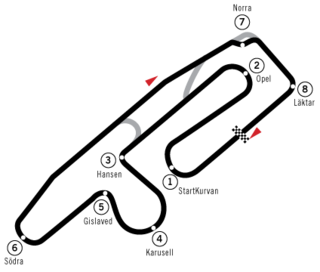
The 1975 Swedish Grand Prix was a Formula One motor race held at the Scandinavian Raceway at Anderstorp on 8 June 1975. It was race 7 of 14 in both the 1975 World Championship of Drivers and the 1975 International Cup for Formula One Manufacturers. It was the sixth Swedish Grand Prix after it was first held as the Swedish Summer Grand Prix in 1933, and the third to be held at Scandinavian Raceway. It was held over 80 laps of the four kilometre circuit for a race distance of 322 kilometres.
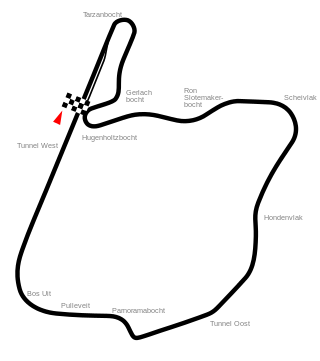
The 1975 Dutch Grand Prix was a Formula One motor race held at Circuit Zandvoort on 22 June 1975. It was race 8 of 14 in both the 1975 World Championship of Drivers and the 1975 International Cup for Formula One Manufacturers. It was the 24th Dutch Grand Prix. It was held over 75 laps of the four kilometre circuit for a race distance of 318 kilometres.

The 1975 British Grand Prix was a Formula One motor race held at Silverstone on 19 July 1975. It was race 10 of 14 in both the 1975 World Championship of Drivers and the 1975 International Cup for Formula One Manufacturers. It was the 30th British Grand Prix to be held since the race was first held in 1926 and the 17th time the race had been held at Silverstone. The race was held over 56 of the scheduled 67 laps of the four kilometre venue for a race distance of 264 kilometres. This was the first race that used the traffic light system with coloured lights at the start.

The 1975 German Grand Prix was a Formula One motor race held at Nürburgring on 3 August 1975. It was race 11 of 14 in both the 1975 World Championship of Drivers and the 1975 International Cup for Formula One Manufacturers. It was the 37th German Grand Prix and the 34th to be held at the Nürburgring. The race was held over 14 laps of the 22.8-kilometre (14.2 mi) circuit for a race distance of 319 kilometres (198 mi).

The 1975 Austrian Grand Prix was a Formula One motor race held at Österreichring on 17 August 1975. It was race 12 of 14 in both the 1975 World Championship of Drivers and the 1975 International Cup for Formula One Manufacturers. It was the eighth Austrian Grand Prix and the sixth to be held at the Österreichring. It was held over 29 of the scheduled 54 laps of the six kilometre circuit for a race distance of 171 kilometres. The race was shortened by heavy rain, meaning that only half points were awarded. The weekend itself was marred by the deaths of Mark Donohue and a track marshal in a practice crash.

The 1975 Italian Grand Prix was a Formula One motor race held at Monza on 7 September 1975. It was race 13 of 14 in both the 1975 World Championship of Drivers and the 1975 International Cup for Formula One Manufacturers. It was the 45th Italian Grand Prix and the 41st to be held at Monza. The race held over 52 laps of the five kilometre circuit for a race distance of 300 kilometres.
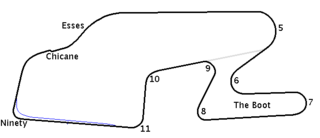
The 1975 United States Grand Prix was a Formula One motor race held on October 5, 1975, at the Watkins Glen Grand Prix Race Course in Watkins Glen, New York. It was race 14 of 14 in both the 1975 World Championship of Drivers and the 1975 International Cup for Formula One Manufacturers. It was the 25th United States Grand Prix since the first American Grand Prize was held in 1908 and the 18th since the first United States Grand Prix at Riverside in 1958.
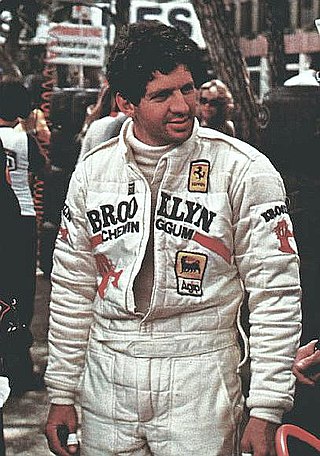
The 1979 Formula One season was the 33rd season of FIA Formula One motor racing. It featured the 1979 World Championship of F1 Drivers and the 1979 International Cup for F1 Constructors which were contested concurrently over a fifteen-round series which commenced on 21 January 1979, and ended on 7 October. The season also included three non-championship Formula One races.

The 1977 Formula One season was the 31st season of FIA Formula One motor racing. It featured the 28th World Championship of Drivers and the 20th International Cup for Formula 1 Constructors. The season commenced on 9 January 1977 and ended on 23 October after seventeen races, making it the longest Formula One season in the sport's history at the time. The season also included a single non-championship race for Formula One cars, the 1977 Race of Champions.
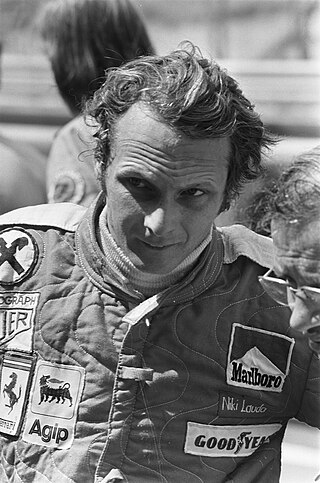
The 1975 Formula One season was the 29th season of FIA Formula One motor racing. It featured the 1975 World Championship of F1 Drivers and the 1975 International Cup for F1 Manufacturers which were contested concurrently from 12 January to 5 October over fourteen races. The season also included three non-championship Formula One races and a nine race South African Formula One Championship.

The 1974 Formula One season was the 28th season of FIA Formula One motor racing. It featured the 1974 World Championship of F1 Drivers and the 1974 International Cup for F1 Manufacturers, contested concurrently over a fifteen-race series which commenced on 13 January and ended on 6 October. The season also included three non-championship races.

The 1978 United States Grand Prix was a Formula One motor race held on October 1, 1978, at the Watkins Glen Grand Prix Race Course in Watkins Glen, New York. This event was also referred to as the United States Grand Prix East in order to distinguish it from the United States Grand Prix West held on April 2, 1978, in Long Beach, California.
